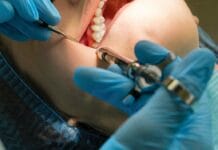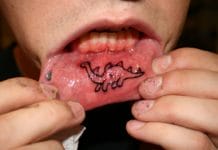Are you in need of CE credits? If so, check out our peer-reviewed, self-study CE courses here.
Test Your Osteonecrosis of the Jaw Knowledge
1. What is osteonecrosis of the jaw?
Osteonecrosis is a condition in which bone cells die due to various causes. Treatment ranges from conservative, aiming to improve the quality of life, to surgical, which often involves debridement of the necrotic bone.1 In extreme cases with pathologic fracture associated with osteonecrosis, reconstruction with a free flap may also be completed if the patient’s health allows.2
1. Lončar Brzak, B., Horvat Aleksijević, L., Vindiš, E., et al. Osteonecrosis of the Jaw. Dentistry Journal. 2023; 11(1): 23. https://doi.org/10.3390/dj11010023
2. Omolehinwa, T.T., Akintoye, S.O. Chemical and Radiation-Associated Jaw Lesions. Dental Clinics of North America. 2016; 60(1): 265-277. https://doi.org/10.1016/j.cden.2015.08.009
2. Which of the following is not a type of osteonecrosis of the jaw?
Osteonecrosis is classified into four categories: medication-related osteonecrosis of the jaw, osteoradionecrosis, traumatic and non-traumatic osteonecrosis, and spontaneous osteonecrosis:
- Medication-related osteonecrosis of the jaw: Osteonecrosis related to antiresorptive or antiangiogenic drugs prescribed to stabilize bone mass loss caused by osteoporosis. The exact mechanism remains unknown; however, it is thought to be induced by the combination of microbial contamination, local trauma, and medications.
- Osteoradionecrosis: A severe side effect of radiation therapy that can affect those treated for head and neck cancer. Some risk factors include trauma (i.e., tooth extraction), cancer therapy radiation dose, tumor site and the area of the bone irradiated, and poor periodontal health.
- Traumatic and non-traumatic osteonecrosis: Traumatic osteonecrosis is caused by mechanical, thermal, or chemical damage. Impact trauma, such as traffic accidents, violence, falls, and sports injuries, may cause bone necrosis. Thermal or chemical osteonecrosis may result from the inappropriate use of some dental materials. For example, though rare, acid etching while placing a restoration triggers bone necrosis.
Non-traumatic osteonecrosis is caused by infections, acquired and congenital disorders, and chemical impact (i.e., narcotic use). Herpes zoster virus, fungal infections, and, in rare cases, tuberculosis, syphilis, and actinomycosis pose a risk of bone necrosis. Though rare, disorders that cause microvascular changes or blood clots have been associated with bone necrosis. Intranasal use of cocaine can lead to palatal perforation, thus exposing bone and inducing necrosis.
- Spontaneous osteonecrosis: Considered very rare, the literature and data on the occurrence of spontaneous osteonecrosis are scarce. Exposed bone, perhaps due to lingual exostoses or prominent bone structures, has been described as a potential predisposing factor.
Lončar Brzak, B., Horvat Aleksijević, L., Vindiš, E., et al. Osteonecrosis of the Jaw. Dentistry Journal. 2023; 11(1): 23. https://doi.org/10.3390/dj11010023
3. Differentiating medication-related osteonecrosis of the jaw from other forms of osteonecrosis is unnecessary.
Medication-related osteonecrosis of the jaw should be differentiated from other forms of osteonecrosis to ensure proper management strategies. The American Association of Oral Maxillofacial Surgeons (AAOMS) staging system provides clinical presentation characteristics, treatment guidelines, and data collection guidance to assess the prognosis and outcomes of patients experiencing medication-related osteonecrosis of the jaw.
The AAOMS stages of medication-related osteonecrosis of the jaw clinical presentation characteristics include:
- Stage 0: No clinical evidence of necrotic bone but non-specific clinical findings and radiographic changes or symptoms.
- Stage 1: Asymptomatic exposed bone, or exposed and necrotic bone or fistula that probes to the bone with no symptoms and no evidence of infection.
- Stage 2: Symptomatic exposed bone, or exposed and necrotic bone or fistula that probes to the bone with evidence of infection, pain, and erythema in the region of exposed bone.
- Stage 3: (Complications) Exposed necrotic bone or fistula that probes to the bone with evidence of infection, pain, and erythema in the region of the exposed bone. With the presence of one or more of the following:
* Exposed and necrotic bone extending beyond the region of the alveolar bone
* Pathologic fracture
* Extra-oral fistula
* Oral-antral or oral-nasal communication
* Osteolysis extending to the inferior border of the mandible or sinus floor
Ruggiero, S.L., Dodson, T.B., Aghaloo, T. et al. American Association of Oral and Maxillofacial Surgeons’ Position Paper on Medication-Related Osteonecrosis of the Jaw - 2022 Update. J Oral Maxillofac Surg. 2022; 80(5): 920-943. https://www.aaoms.org/docs/govt_affairs/advocacy_white_papers/mronj_position_paper.pdf
4. Osteoradionecrosis is a severe side effect of radiation therapy, which can affect people with head and neck cancer. It can also occur as a side effect of chemotherapy used for lung cancer.
Osteoradionecrosis is a condition associated with radiation treatment. The pathophysiology is unclear; however, two theories that have been proposed suggest that “radiation leads to radiation arteritis, which consequently induces the formation of hypoxic, hypovascular, and hypocellular tissue. Due to hypoxia, the tissue cannot be renewed, and the wounds cannot heal.”1
A second theory suggests “radiation-induced fibrosis, which presumes that radiation induces changes in fibroblastic activity, which happen during three different phases: prefibrotic phase, continuously organized phase and late fibroatrophic phase.” 1 This theory suggests that disruption of fibroblasts prevents proper healing.
Osteonecrosis associated with chemotherapy would be classified as medication-induced osteonecrosis of the jaw rather than osteoradionecrosis.
1. Lončar Brzak, B., Horvat Aleksijević, L., Vindiš, E., et al. Osteonecrosis of the Jaw. Dentistry Journal. 2023; 11(1): 23. https://doi.org/10.3390/dj11010023
5. The risk of developing osteoradionecrosis after an extraction increases in the years following radiation therapy, peaking in the fifth year.
The overall risk of developing osteoradionecrosis of the jaw from therapeutic radiation is estimated to be 2%. Certain factors increase this risk, including invasive dental procedures (primarily tooth extraction), tumor location and area of irradiated bone, oral hygiene, periodontal health, smoking and alcohol consumption, and uncontrolled diabetes.
The risk of developing osteoradionecrosis after an extraction is 7%. This risk gradually increases for extractions between the second and fifth years postradiation, reaching a peak risk of 22.6%. After the fifth year postradiation, the risk decreases to 16.7%.
Lončar Brzak, B., Horvat Aleksijević, L., Vindiš, E., et al. Osteonecrosis of the Jaw. Dentistry Journal. 2023; 11(1): 23. https://doi.org/10.3390/dj11010023
Before you leave, check out the Today’s RDH self-study CE courses. All courses are peer-reviewed and non-sponsored to focus solely on high-quality education. Click here now.












